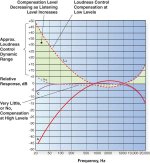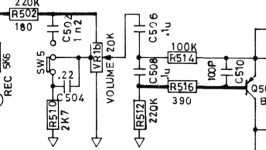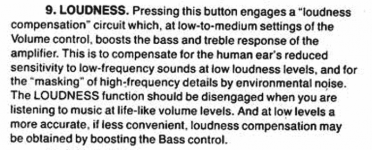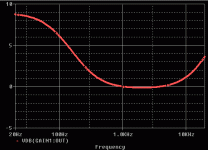Specifications
- Power output: 20 watts per channel into 8Ω (stereo)
- Frequency response: 10Hz to 70kHz.
- Total harmonic distortion: 0.02%
- Damping factor: 55.
- Input sensitivity: 2.5mV (MM), 150mV (line)
- Signal to noise ratio: 75dB (MM), 110dB (line)
- Dimensions: 420 x 96 x 240mm.
- Weight: 5.26kg.
If you own that model, why not measure the loudness contour?
I’m not an Electrical Engineer. Just an owner. I like its loudness contour characteristics and would like to copy to my parametric equalizer.
Specifications
- Power output: 20 watts per channel into 8Ω (stereo)
- Frequency response: 10Hz to 70kHz.
- Total harmonic distortion: 0.02%
- Damping factor: 55.
- Input sensitivity: 2.5mV (MM), 150mV (line)
- Signal to noise ratio: 75dB (MM), 110dB (line)
- Dimensions: 420 x 96 x 240mm.
- Weight: 5.26kg.
Sorry, that’s not what I’m asking for. Thank you very much though
The characteristics are taken in the form of curves of the dependence of the output voltage on the frequency of the input sinusoidal signal. A signal generator or smartphone app is being used.
Several curves are taken at different volume levels.
A logarithmic scale is usually used.
Several curves are taken at different volume levels.
A logarithmic scale is usually used.
Like most 70's-80's amplifiers, the loudness characteristic is defined first by the specific type of tapped potentiometer (there are 4 connections to each wafer of the stereo volume control and one is a tap at about half volume). Then the roll-off frequency and depth is set by a quite simple little RC filter that reduces high frequencies more as you turn the volume down below the point where the tap is located.I’m not an Electrical Engineer. Just an owner. I like its loudness contour characteristics and would like to copy to my parametric equalizer.
There's quite a problem to duplicate the control though. You need a dual, tapped 20k log or audio taper potentiometer. Good luck finding any affordable tapped pot with the same characteristic now and you'll need a miracle to find the exact type for your particular version of the 3020. (there were many versions over the years)
The best you can hope for is a fairly close version but I doubt you'll find just what you need. The reference schematics show the filter and volume control as described on several NAD models and the volume control with the associated switch and RC filter is identified as VR1a and b on early model schematics showing the switching and tone control section and other sections of the amplifier in separate diagrams. You can find these at hifiengine and elsewhere on the net.
Last edited:
A typical loudness control compensation is shown in the attachment (dotted red line). It shows a large boost at low frequencies, a smaller boost at high frequencies and a slight dip at mid frequencies. This may give you a guide as to how to set your equaliser.I like its loudness contour characteristics and would like to copy to my parametric equalizer.
The graph is taken from: The Mysterious Loudness Control: What Does It Do? | Extron
Attachments
I've got the specs! Here is the info for those who are seeking like me. Bass is boosted at 50Hz and Treble is boosted at 10kHz. Regrettably, levels are unknown.
My another question unrelated to this thread; as seen that the loudness contour is usually boosted at the same frequencies as bass/ treble knobs, then, can it be boosted over the tone control's dB range?
My another question unrelated to this thread; as seen that the loudness contour is usually boosted at the same frequencies as bass/ treble knobs, then, can it be boosted over the tone control's dB range?
1. The levels depend on the angle of rotation of the volume control.
2. A normal tone control operates at the same frequencies.
Avoid overloading the amplifier and speakers (and neighbors).
I know that a good loudness circuit should vary levels depend on volume. But many other manufacturers often show the loudness level specs at a reference volume, not sure, usually @ -30dB. For the tone control, I’m wondering if the limit of boost/ cut range is +/- 5 dB, can we design the loudness that boost over 5 dB, say approximately +10dB?
Circuit from the service manual...
Attachments
- Status
- This old topic is closed. If you want to reopen this topic, contact a moderator using the "Report Post" button.
- Home
- Amplifiers
- Solid State
- NAD 3020 Loudness




